Looking for the perfect skis that balance fun, portability, and performance? Here’s the deal: short skis are changing the game. While traditional long skis from brands like Nordica and Salomon dominate the slopes, smaller options like Snowfeet’s Mini Ski Skates and Skiblades offer a lightweight, easier-to-use alternative. Whether you’re a beginner, an experienced skier, or just someone who wants to pack light, there’s something here for you.
Key Takeaways:
- Snowfeet Mini Ski Skates (38 cm): Ultra-compact and beginner-friendly, starting at $150.
- Snowfeet PRO (50 cm): A step up in performance for $199.
- Skiskates (44 cm): Great balance of control and agility, priced at $340–$380.
- Skiblades (65–99 cm): Versatile options for advanced skiers, $450–$490.
- Snowfeet Short Skis (120 cm): A compact take on classic skiing, priced at $690.
- Traditional Skis: Great for speed and deep powder but bulkier and pricier ($800–$1,200+).
- Snowboards: Fun for parks and powder but harder to learn and transport ($750–$1,600 total setup).
Quick Comparison:
| Model | Length | Best For | Price (USD) |
|---|---|---|---|
| Snowfeet Mini Skates | 38 cm | Beginners, portability | $150 |
| Snowfeet PRO | 50 cm | Intermediate skiers | $199 |
| Skiskates | 44 cm | Agility, compact trips | $340–$380 |
| Skiblades | 65–99 cm | Advanced, versatile use | $450–$490 |
| Snowfeet Short Skis | 120 cm | All-around performance | $690 |
| Traditional Skis | 150–180 cm | Speed, deep powder | $800–$1,200+ |
| Snowboards | 58–62 in | Parks, freestyle | $750–$1,600 |
Whether you’re after a compact, budget-friendly option or a high-performance setup, this guide breaks down the pros, cons, and prices to help you pick the best gear for your next adventure.
Snowboarder tries Snowfeet* | Which Snowfeet* Short Ski is the Best? | Snowblades 44, 65, 99 Review
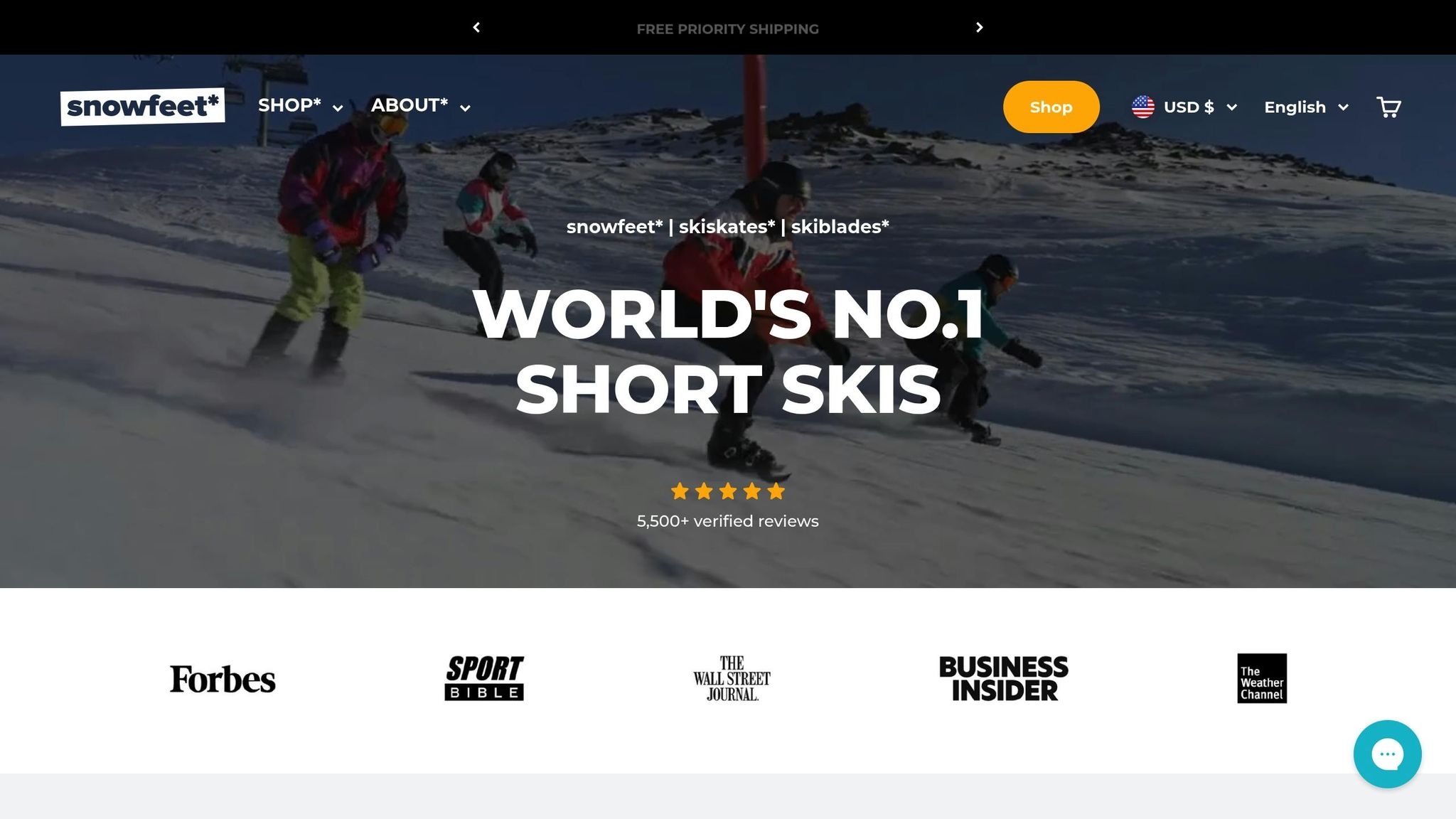
1. Snowfeet* Mini Ski Skates (38 CM)
The Snowfeet* Mini Ski Skates bring a fresh twist to winter sports gear. At just 15 inches long, these miniature skis attach directly to your winter boots or snowboard boots, cutting out the need for bulky equipment.
Portability
Forget lugging around heavy ski boots, poles, and long skis. These Mini Ski Skates are so compact they can slip right into your backpack. Whether you're heading to a local hill or planning a last-minute adventure, their lightweight design makes them a breeze to carry.
"I love that I can just pop these in a backpack, along with some telescoping hiking poles & snowboard boots." - Hunter Zuniga, Customer Review
This portability doesn’t just make them convenient - it also opens up a world of possibilities for where and how you can use them.
Terrain Options
Thanks to their 38cm length, these skates can handle a variety of terrains. They shine on groomed ski slopes, snow parks, hiking trails, cross-country paths, and even your backyard hill. The metal edges give you solid control and stopping power, much like traditional skis. That said, they’re not the best choice for deep powder (anything over 4 inches) or extremely steep, uneven terrain.
Learning Curve
Their compact size and low center of gravity make balancing and steering easier, which is great news for beginners.
"Snowfeet is so light & easy to learn after about 1 hour of practice." - Fiona T, Customer Review
Plus, they’re so comfortable that many users say they forget to unclip them after walking around - something you’d never hear about clunky ski boots.
Price Range (USD)
Starting at $150, the Mini Ski Skates are an affordable alternative to traditional ski gear.
"I'm not nearly as sore as I normally would be using traditional skis." - Hunter Zuniga, Customer Review
2. Snowfeet PRO (50 CM)
The Snowfeet PRO takes the concept of Mini Ski Skates to the next level. Measuring about 20 inches (50 cm) in length, it offers a blend of portability and performance that appeals to modern skiers looking for convenience without sacrificing functionality.
Portability
With its compact 50 cm size, the Snowfeet PRO attaches directly to your boots, doing away with the need for bulky ski gear. You can easily toss it into a backpack, making it perfect for those who value traveling light. As the Snowfeet Store puts it:
"Why carry heavy ski gear when you can slip into Snowfeet?"
Learning Curve
One of the standout features of the Snowfeet PRO is its lightweight design, which reduces physical strain and makes it easier for skiers to get the hang of it. This simplicity makes it a great alternative to traditional skis and snowboards, which can often feel cumbersome and intimidating to beginners.
Price Range (USD)
At $199, the Snowfeet PRO offers a high-performance experience at a much lower price point than traditional ski equipment. This affordability, combined with its portability, makes it an attractive option for those looking to hit the slopes without breaking the bank. As Snowfeet Store highlights:
"Far more portable – and affordable – than traditional skis or snowboards."
3. Skiskates (44 CM)
Sitting snugly between the Mini Ski Skates and the PRO model, Skiskates strike a perfect balance of agility and stability. At 17.3 inches (44 cm), these short skis are designed for skiers who crave maximum maneuverability without giving up the steadiness needed for a smooth ride. They promise a unique experience on the slopes, blending fun with control.
Portability
At just 44 cm in length, Skiskates are incredibly easy to carry compared to traditional skis, which are typically 150-180 cm long. They’re small enough to fit into a backpack, making them ideal for last-minute mountain trips or as a backup pair when you’re on the go. Forget about bulky ski bags and roof racks - Skiskates can even fit into your standard luggage. This convenience makes them a great choice for skiers who value portability as much as performance.
Terrain Options
Skiskates really shine on groomed ski slopes, where they allow for smooth skating motions, quick jumps, and sharp turns. Their shorter length makes edge-to-edge transitions faster and more responsive compared to traditional skis, which can feel cumbersome in such situations.
While traditional skis are better suited for deep powder and off-piste adventures, Skiskates are all about fun and precision on packed snow. Their playful design transforms the way you experience the mountain, offering something fresh for skiers who love speed and agility.
Learning Curve
Learning to use Skiskates is described as quick and enjoyable. If you’ve got experience in rollerblading or ice hockey, you’ll likely find the transition to Skiskates pretty straightforward. Their short length means there’s less ski to manage, which can actually help you pick up the technique faster.
Unlike traditional skis that can overwhelm beginners with their size and weight, Skiskates encourage you to fine-tune your balance and edge control right from the start. It’s a fun challenge that rewards you with better skills in no time.
Price Range (USD)
Skiskates come in two options: $340 for ski boot bindings and $380 for snowboard boot bindings. While they may cost more than the Mini Ski Skates, they offer professional-grade features like a wood core and cap construction, similar to what you’d find in full-sized skis.
In terms of pricing, Skiskates are comparable to entry-level ski packages but with the added benefits of portability and unique performance. Plus, their 4.6-star rating on Ubuy highlights how much users appreciate their quality and performance.
4. Skiblades (65 CM)
Building on the success of Skiskates, Skiblades take versatility to a whole new level. At 25.6 inches (65 cm), these skiblades hit the sweet spot between stability and playfulness. They offer more control than their shorter counterparts while keeping the lively, easy-to-maneuver feel that Snowfeet* products are known for. Perfect for skiers who want a bit more stability without losing the fun factor.
Portability
Despite their slightly longer length, Skiblades are still super easy to carry compared to traditional skis. You can fit them into most ski bags, dodging those dreaded oversized luggage fees. Their compact size makes them a great choice for quick mountain getaways or as a backup pair for switching things up mid-day.
Plus, they’re lightweight, which is a game changer for skiers who need to hike to their favorite slopes or move between different areas. Forget roof racks or complicated transport setups - Skiblades fit comfortably in most cars, making them a hassle-free option for spontaneous adventures.
Terrain Options
Skiblades shine on groomed slopes and in snowparks. Their 65 cm length gives you the stability you need for carving while still allowing for quick edge-to-edge transitions. They’re fantastic for freestyle skiing and tricks that might feel clunky on longer skis.
While brands like Nordica, Völkl, and Salomon cater their all-mountain skis to deep powder and high-speed runs, Skiblades focus on agility and creativity. Their shorter length makes them perfect for tight turns, narrow spaces, and weaving through crowded slopes - all things that can be tricky with traditional long skis.
Learning Curve
Skiblades are a great choice for skiers looking to improve their skills. Their shorter length makes turning easier, while still offering enough stability to practice proper carving techniques. They’re especially beginner-friendly for adults who might find traditional skis intimidating or heavy.
These skiblades encourage you to concentrate on balance and edge control instead of wrestling with oversized gear. They’re also a solid pick for snowboarders transitioning to skiing or anyone returning to the slopes after a long break.
Price Range (USD)
Priced at $450, Skiblades pack a lot of advanced features into a compact design. While they’re a bit pricier than shorter Snowfeet* models, they still come in well below the cost of premium all-mountain skis, which often run $600-$800 or more (and that’s without bindings).
For the price, you’re getting a high-quality, professional-grade product that delivers both portability and unique performance. It’s a solid investment for skiers who want something versatile and fun without breaking the bank.
Next up, we’ll take a closer look at the longer Snowfeet* models and how they build on this performance.
5. Skiblades (99 CM)
At 99 cm, these Skiblades strike a balance between compact agility and the performance you’d expect from traditional skis. They’re faster and more stable than shorter options, yet they keep that high level of maneuverability that makes Snowfeet* products stand out. This length is perfect for skiers who want the perks of short skis without giving up the familiar feel of longer gear.
The 99 cm design is also a great stepping stone for those transitioning from standard all-mountain skis. It brings the modern benefits of short skis in a way that feels approachable and easy to adapt to. Plus, they’re easier to carry around, which is always a bonus.
Portability
Even at 99 cm, these Skiblades are easy to pack. They fit into standard ski bags and car trunks without any hassle, making them ideal for road trips or quick mountain escapes. Compared to heavier all-mountain skis from brands like Salomon or Rossignol, these are much lighter and more travel-friendly - perfect for skiers on the move.
Terrain Options
These Skiblades handle a variety of terrains with ease. They glide smoothly over light powder and make quick, sharp turns on groomed slopes. In terrain parks, their nimbleness shines, making spins, jumps, and rail tricks a breeze. While traditional skis often focus on speed and stability, these are all about versatility and having fun across different mountain conditions.
Learning Curve
For intermediate and advanced skiers, the 99 cm length offers an easier learning curve. Their shorter size helps improve balance and edge control, which is great for refining carving skills. They’re also a fantastic tool for instructors who want to demonstrate techniques more effectively.
Price Range (USD)
Priced at $490, these Skiblades deliver excellent performance without breaking the bank. Compared to traditional all-mountain skis, which can range from $700 to $1,200, they’re a more affordable way to enjoy the benefits of short ski technology. For the price, you’re getting a versatile, high-performing option that works across various terrains - a smart choice for anyone looking to shake up their winter sports experience.
sbb-itb-17ade95
6. Snowfeet POWDER (99 CM)
The Snowfeet POWDER (99 CM) is built for powder lovers seeking a shorter, more agile alternative to traditional skis. Designed with deep snow in mind, it offers a balance of floatation and sharp handling that modern skiers crave. This 99 cm skiblade is a fresh take on winter gear, specifically tuned for powder performance. Snowfeet* has clearly aimed to make powder skiing more approachable and fun with this compact yet capable design.
Portability
Measuring just 99 cm and made with lightweight materials, the POWDER is a breeze to transport. Whether you’re packing it into a small car or stashing it in a corner of your hotel room, its compact size ensures you won’t have to wrestle with bulky gear. It’s all about convenience, so you can focus on shredding the slopes.
Terrain Options
This model shines in deep snow. While some skis are built for groomed trails, the POWDER is all about delivering smooth floatation and easy control in powdery conditions. It’s perfect for backcountry adventures or any terrain where traditional skis might feel cumbersome. Think of it as your go-to for powder days without the hassle of oversized gear.
Learning Curve
The Snowfeet POWDER’s size makes it a friendly option for skiers exploring powder for the first time. Its responsive design helps beginners build confidence while giving seasoned skiers a chance to fine-tune their skills. No need to feel overwhelmed by heavy, hard-to-handle equipment - this setup keeps things simple and fun.
Price Range (USD)
Priced at $490, the Snowfeet POWDER delivers a solid mix of performance and value. It’s a more affordable entry into powder skiing compared to traditional skis, making it a smart pick for those wanting quality without breaking the bank.
7. Snowfeet Short Skis (120 CM)
The Snowfeet Short Skis (120 CM) combine the classic skiing experience with the growing trend of short skis. At just under 4 feet long, they give skiers a familiar feel while proving you don’t need 160–180 cm skis to carve up the slopes like a pro.
Portability
At 120 cm, these skis are a game-changer when it comes to portability. Unlike the bulkier 160–180 cm models from brands like Rossignol or Salomon, these skis fit easily into a car’s back seat, a standard ski bag, or even a corner of your hotel room. Forget about struggling with roof racks or awkwardly carrying long skis through crowded lodges - these are compact enough to make travel and storage a breeze. They’re also a dream for anyone using public transportation to reach their favorite mountain.
Terrain Options
These short skis shine across a variety of terrains. Whether you’re cruising groomed runs, weaving through moguls, navigating tree lines, or floating on powder, their shorter length makes them incredibly nimble. The reduced size eliminates the common tip-crossing issues you get with longer skis, giving you more confidence in tight spaces. Plus, they handle different snow conditions - hardpack, fresh powder, you name it - like a champ, making them a solid choice for resorts with mixed terrain.
Learning Curve
Switching from traditional skis? These 120 cm short skis make it easy. Their shorter length and lighter swing weight make turning smoother and give you better control. Beginners will love how quickly they can build confidence, while seasoned skiers will appreciate the stability and the chance to refine their technique. Advanced skiers, in particular, can push their limits without feeling bogged down by heavy, unwieldy gear.
Price Range (USD)
With a price tag of $690, these skis come in well below the cost of traditional setups, which often run between $800 and $1,200. Another bonus? You can use them with your existing winter or snowboard boots, so there’s no need to shell out extra cash for ski-specific footwear. Up next, we’ll see how these short skis stack up against standard models from big-name brands.
8. Standard Skis (Nordica, Völkl, Salomon, etc.)
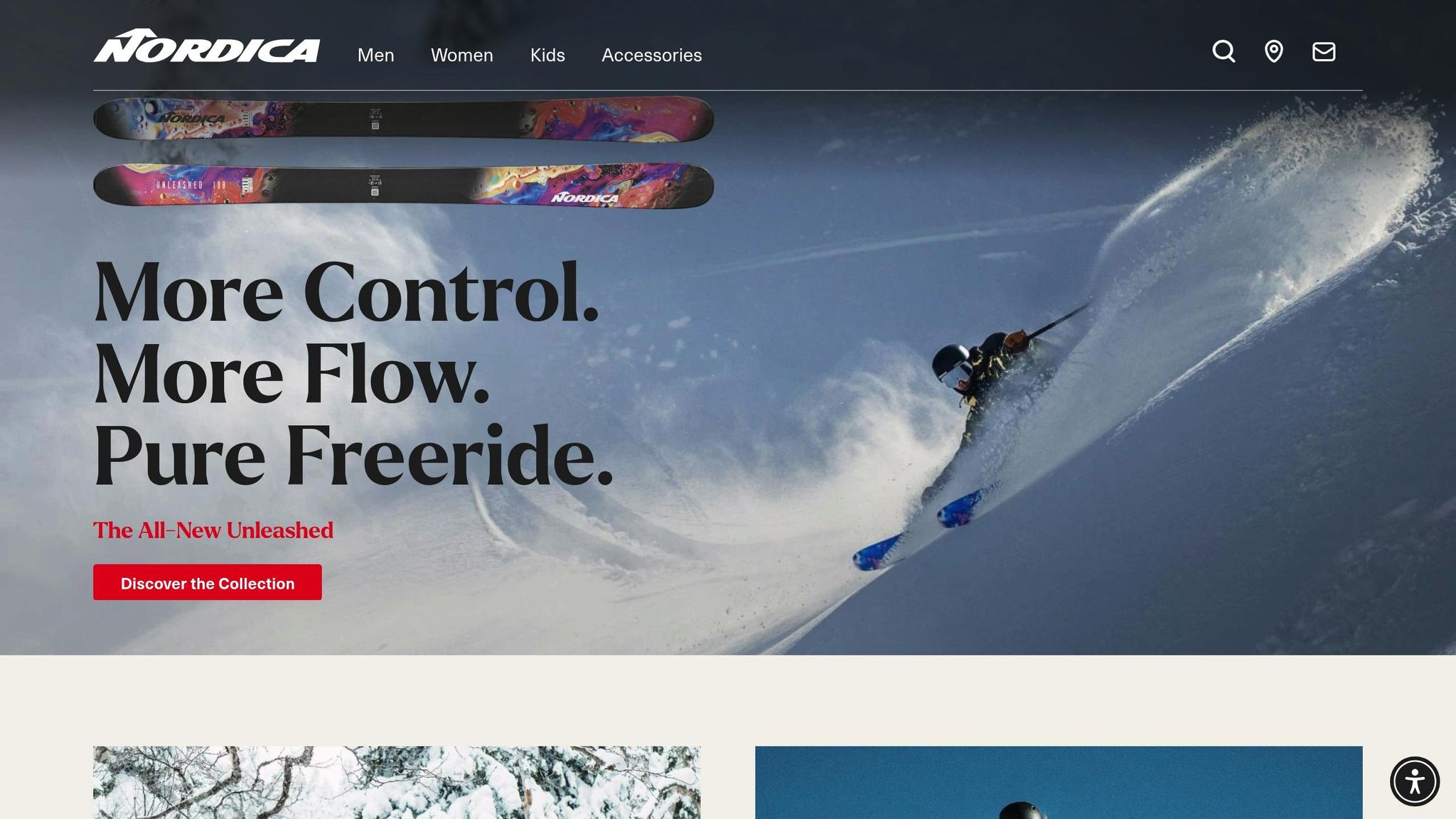
Traditional all-mountain skis from well-known brands like Nordica, Völkl, Salomon, and Rossignol have been a staple in skiing for years. While they stick to classic designs that focus on performance and reliability, they stand in contrast to Snowfeet's more compact and agile approach.
Portability
Let’s face it - standard skis aren’t exactly travel-friendly. They require roof racks, oversized travel bags, or some serious logistical planning to haul around. This is where Snowfeet shines, offering a lightweight and compact alternative that’s much easier to manage.
Terrain Options
Standard skis are built for groomed runs and excel at delivering consistent performance on these surfaces. Decades of design tweaks have made them reliable for traditional skiing styles. That said, their longer length can make quick transitions a bit tricky. Snowfeet, on the other hand, is all about agility - perfect for skiers who want to navigate tight spots or make fast moves without missing a beat.
Price Range (USD)
When it comes to cost, traditional skis often come with a heftier price tag. Snowfeet provides a more budget-friendly option while still delivering a modern, high-performing experience. For skiers looking for value without compromising on fun, Snowfeet might just hit the sweet spot.
9. Snowboards (Leading Brands)
Brands like Burton, Lib Tech, Jones, and Capita have set the standard for snowboards, offering innovative ways to carve up the mountain. While these traditional snowboards bring their own flair and functionality, Snowfeet's compact skis provide a fresh take on agility and portability. Each has its perks - and its challenges.
Portability
Traditional snowboards, typically 58–62 inches long, require some logistical effort. Think board bags, roof racks, and extra space in your car. Snowfeet, on the other hand, are incredibly compact, making them much easier to transport. Whether you're tossing them in a backpack or stashing them in a suitcase, they’re a game-changer for hassle-free travel.
Terrain Options
Top snowboard brands design their all-mountain boards to handle a variety of conditions, from groomed trails to fresh powder and even park features. But when it comes to icy or hard-packed snow, snowboards can sometimes struggle with precise edge control. Snowfeet, thanks to their compact design, excel in agility and are easier to maneuver, offering a unique advantage in certain conditions.
Learning Curve
Snowboarding isn't exactly beginner-friendly. Emilio Trampuz puts it best:
"A total beginner will find skiing easier than snowboarding. That's because a 'snowplow' or wedge position that a beginner skier usually learns first is a more stable platform, while a snowboarder has to get used to balancing on a single sharp edge, which is more difficult".
The sideways stance, frequent tumbles, and overall balance requirements can make learning snowboarding a bit of a grind. Snowfeet, with their forward-facing stance and independent leg movement, offer a setup that feels closer to skiing. This might make them a better fit for beginners who want a smoother start.
Price Range (USD)
Snowboarding can hit the wallet hard. Boards typically cost between $400 and $700, with high-end models often exceeding $800. Then there’s the gear - boots can range from $200 to $500, and bindings add another $150 to $400. All in, you're looking at an investment of $750 to $1,600. Snowfeet, however, present a more affordable option, delivering the thrill of winter sports without the hefty price tag.
These comparisons lay the groundwork for a closer look at the overall pros and cons of each option.
Pros and Cons
Here’s a quick breakdown of the strengths and drawbacks for Snowfeet* products, traditional skis, and snowboards:
| Category | Snowfeet* Products | Traditional Skis | Snowboards |
|---|---|---|---|
| Portability | Excellent – Compact enough to fit in a backpack, no need for roof racks or bulky cases. | Low – Require roof racks, ski bags, and take up significant space. | Moderate – Need board bags and careful handling during transport. |
| Learning Curve | Easy – Forward-facing stance and independent leg movement make it beginner-friendly. | Moderate – Familiar for many, but coordinating two skis takes practice. | Challenging – Sideways stance can be tricky for beginners to master. |
| Terrain Versatility | Good – Works well on groomed runs, parks, and icy surfaces, but needs extra skill in deep powder. | Excellent – Handles everything from packed snow to powder with ease. | Good – Great in powder and parks but struggles on icy terrain. |
| Cost (Initial Investment) | Budget-Friendly – Starting around $150, it’s a low-cost way to hit the slopes. | Higher Cost – Requires a bigger investment for skis, boots, bindings, etc. | Higher Cost – Snowboards and related gear can be a pricey commitment. |
| Maneuverability | Excellent – Quick turns and agile handling, perfect for tight spaces. | Good – Stable but less nimble, requiring more room for sharp turns. | Fair – Smooth for carving but not ideal for rapid directional changes. |
| Speed & Stability | Moderate – Reliable at moderate speeds, but shorter length means less stability at high speeds. | Excellent – Built for stability and control during fast descents. | Good – Stable, but edge control isn’t as sharp as skis. |
| Physical Demand | Low – Reduces leg fatigue and joint stress, making it easier on the body. | Moderate – Requires steady leg strength and endurance for a full day. | High – Demands more core and leg strength, especially for balance. |
| Lift Compatibility | Good – Works with most ski lifts, though it’s worth checking specific mountain policies. | Excellent – Universally accepted at ski lifts. | Good – Standard equipment compatible with most lifts. |
| Storage & Maintenance | Minimal – Easy to store and requires basic waxing and upkeep. | High – Needs ample storage and regular tuning for best performance. | Moderate – Requires some storage space and routine waxing. |
Why Choose Snowfeet*?
Snowfeet* products shine when it comes to portability. You can literally toss them in a backpack, making them perfect for spontaneous trips. They’re also a budget-friendly option, costing much less than traditional skis or snowboards. Plus, the forward-facing stance feels natural, making it easier for beginners to get the hang of things compared to snowboarding’s sideways stance.
Things to Keep in Mind
Snowfeet* products aren’t without their challenges. They’re not the best choice for deep powder, where traditional skis tend to excel. And while they’re great for groomed runs and parks, they might not offer the same stability at high speeds as longer skis. If you’re into advanced terrain park features, you might find some Snowfeet* models less suited for those big jumps and technical landings.
So, if you’re all about convenience, affordability, and an easy learning curve, Snowfeet* is a fantastic choice for recreational skiing. But if you’re chasing high-speed thrills or tackling specialized conditions like deep powder, traditional skis might be worth the extra investment.
Final Recommendations
Snowfeet* gear offers an impressive mix of portability, affordability, and performance. Based on the details above, pick the model that matches your skill level and the terrain you love to conquer.
For beginners
The Snowfeet Mini Ski Skates (38 CM), priced at $150, are perfect for those just starting out. They’re compact, lightweight, and skip the hassle of bulky traditional skis from brands like Nordica or Salomon.
For intermediate skiers
The Snowfeet PRO (50 CM), available for $199, delivers a responsive and agile ride. It’s great for refining your skills, tackling tighter turns, and stepping up your game faster than you would with standard skis.
For advanced skiers
The Skiblades (99 CM), starting at $490, pack serious performance into a compact design. They’re versatile enough to handle all-mountain terrain without the weight or expense of conventional ski setups.
For powder lovers
The Snowfeet POWDER (99 CM), also priced at $490, excels in fresh snow. They’re built for smooth transitions between powder and groomed runs, and they make weaving through tree lines a breeze.
Why Snowfeet* Stands Out
Ranging from $150 to $690, Snowfeet* gear ditches the heavy, clunky equipment. Their sleek design promotes a natural forward-facing stance and independent leg movement, making them easier to learn than snowboarding’s sideways stance or the coordination-heavy demands of traditional skis.
The Takeaway
Say goodbye to oversized gear and hello to a new way of skiing. Snowfeet* proves that smaller can be smarter, giving you high performance in a compact package. Ready to redefine your mountain adventures? This is your chance.
FAQs
How do Snowfeet products compare to traditional skis and snowboards in terms of performance and portability?
Snowfeet gear is all about convenience and performance wrapped into one sleek package. Thanks to their compact and lightweight design, they’re super easy to carry, store, and transport. If you’re someone who loves winter adventures but hates lugging around bulky equipment, these are a game-changer.
On the slopes, Snowfeet products shine with their quick, precise maneuverability, making them perfect for tackling different terrains effortlessly. Unlike traditional skis, which can be cumbersome and take more effort to handle, Snowfeet gear focuses on fun, agility, and ease of use. They’re designed to suit everyone, whether you’re a beginner finding your footing or a seasoned pro carving up the slopes. With Snowfeet, you get a fresh, no-fuss way to enjoy winter sports.
Can I use Snowfeet products in deep powder, or are traditional skis a better choice for those conditions?
Snowfeet products are all about versatility and fun. They’re perfect for groomed trails, slopes, and packed snow. But if you’re heading into deep powder, they might not be your best bet. That’s where traditional skis, with their wider bases, shine - they’re built to float and handle those conditions with ease.
For deep powder adventures, stick with traditional skis. But for everyday skiing or mixed terrains, Snowfeet products bring something special to the table. They’re lightweight, easy to control, and super portable - features that traditional skis just can’t compete with.
Why are Snowfeet products a great choice for beginners compared to traditional skis or snowboards?
Snowfeet gear is a fantastic choice for beginners, and here’s why: they’re lightweight, compact, and super easy to handle. Unlike traditional skis or snowboards that can feel overwhelming, Snowfeet’s shorter length (15–47 inches) makes controlling them a breeze. This means new riders can find their footing quickly and enjoy gliding down the slopes with confidence.
Another big win? Their versatility. Snowfeet products work with regular winter shoes, so you don’t need to invest in pricey, specialized boots. This not only makes getting started less expensive but also simplifies the whole process of gearing up. Plus, thanks to their portable size, you can toss them in your bag and head out for an impromptu winter adventure anytime. For anyone just starting out, Snowfeet offers an easy and fun way to dive into the excitement of skiing - without the stress of mastering traditional equipment.





















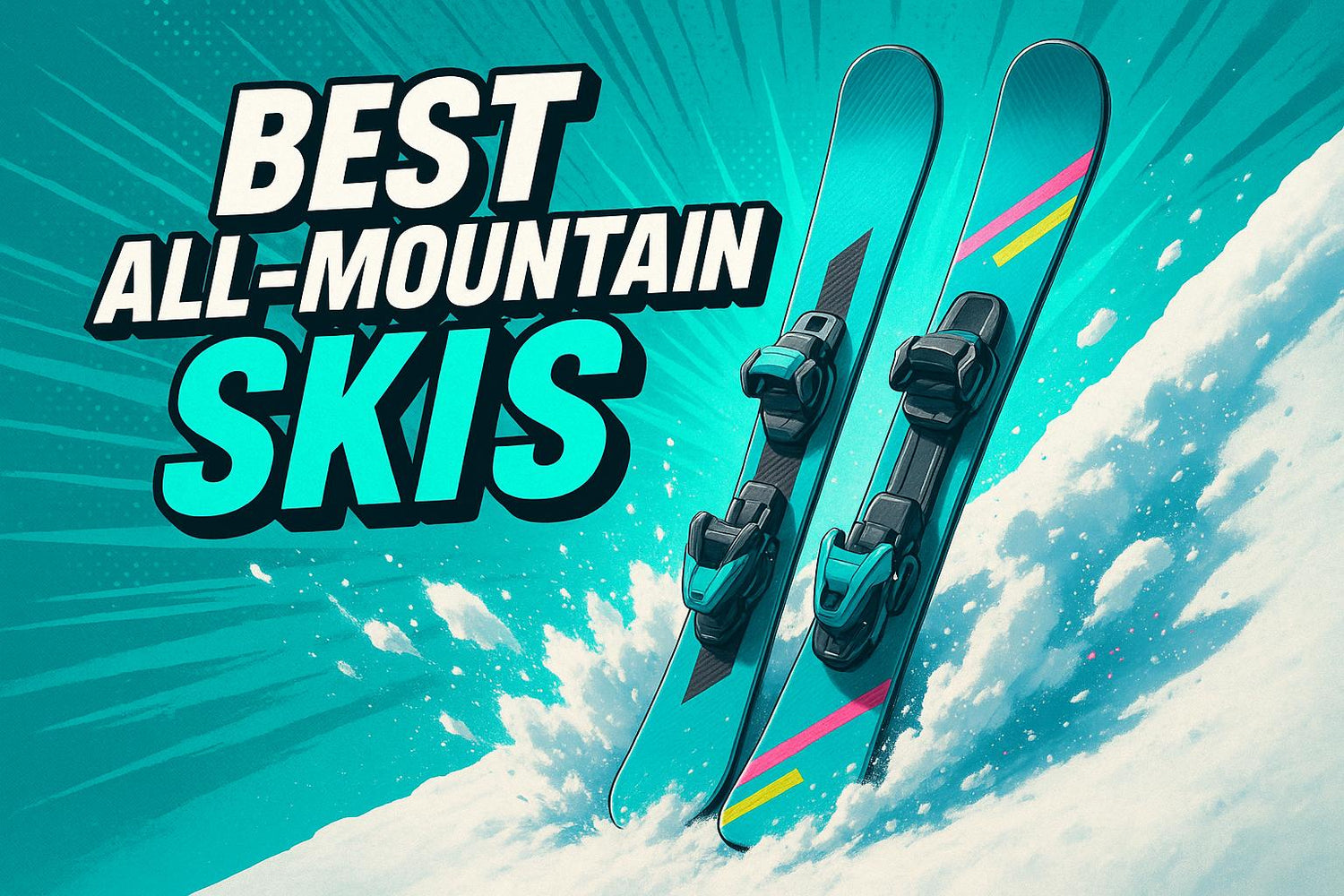
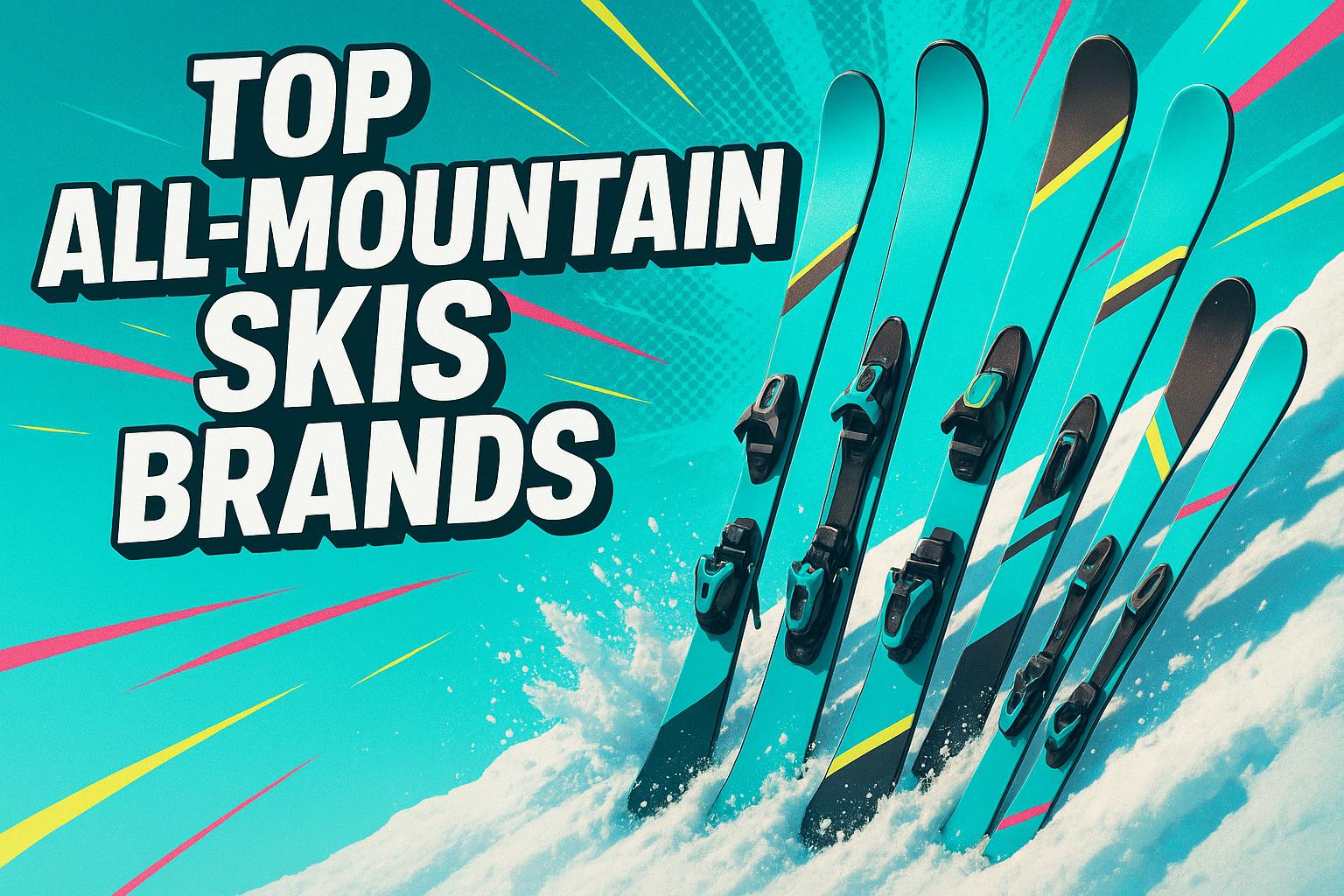
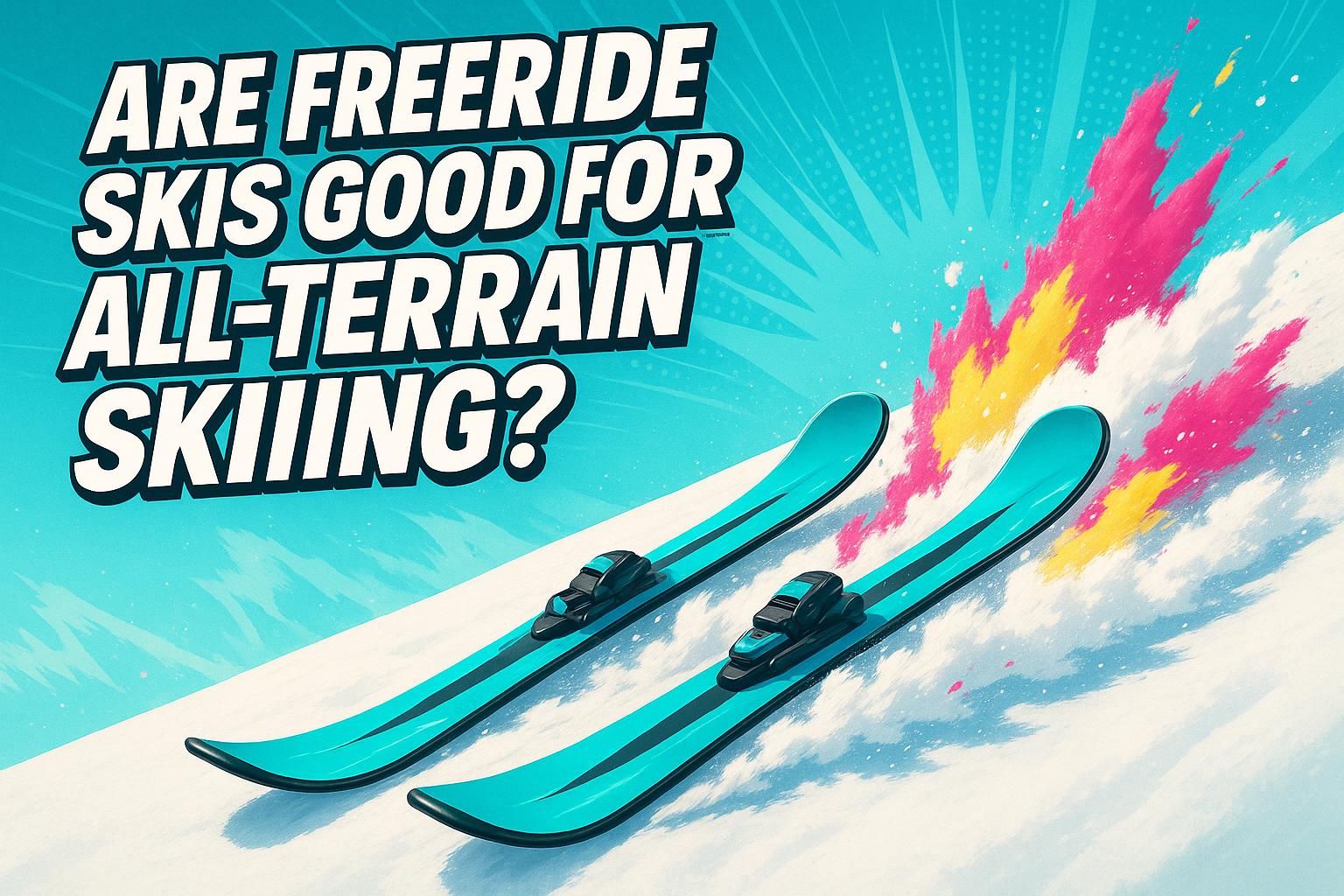










Leave a comment
This site is protected by hCaptcha and the hCaptcha Privacy Policy and Terms of Service apply.